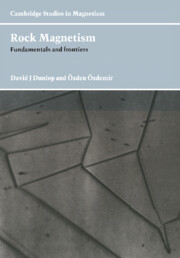Book contents
- Frontmatter
- Contents
- Preface
- Chapter 1 Magnetism in nature
- Chapter 2 Fundamentals of magnetism
- Chapter 3 Terrestrial magnetic minerals
- Chapter 4 Magnetostatic fields and energies
- Chapter 5 Elementary domain structures and hysteresis
- Chapter 6 Domain observations
- Chapter 7 Micromagnetic calculations
- Chapter 8 Single-domain thermoremanent magnetization
- Chapter 9 Multidomain thermoremanent magnetization
- Chapter 10 Viscous and thermoviscous magnetization
- Chapter 11 Isothermal magnetization and demagnetization
- Chapter 12 Pseudo-single-domain remanence
- Chapter 13 Crystallization remanent magnetization
- Chapter 14 Magnetism of igneous rocks and baked materials
- Chapter 15 Magnetism of sediments and sedimentary rocks
- Chapter 16 Magnetism of metamorphic rocks
- Chapter 17 Magnetism of extraterrestrial rocks
- References
- Index
Chapter 13 - Crystallization remanent magnetization
Published online by Cambridge University Press: 06 July 2010
- Frontmatter
- Contents
- Preface
- Chapter 1 Magnetism in nature
- Chapter 2 Fundamentals of magnetism
- Chapter 3 Terrestrial magnetic minerals
- Chapter 4 Magnetostatic fields and energies
- Chapter 5 Elementary domain structures and hysteresis
- Chapter 6 Domain observations
- Chapter 7 Micromagnetic calculations
- Chapter 8 Single-domain thermoremanent magnetization
- Chapter 9 Multidomain thermoremanent magnetization
- Chapter 10 Viscous and thermoviscous magnetization
- Chapter 11 Isothermal magnetization and demagnetization
- Chapter 12 Pseudo-single-domain remanence
- Chapter 13 Crystallization remanent magnetization
- Chapter 14 Magnetism of igneous rocks and baked materials
- Chapter 15 Magnetism of sediments and sedimentary rocks
- Chapter 16 Magnetism of metamorphic rocks
- Chapter 17 Magnetism of extraterrestrial rocks
- References
- Index
Summary
Introduction
Crystallization remanent magnetization (CRM) results from the formation of a new magnetic mineral in the presence of a magnetic field, either by nucleation and growth to a stable blocking volume VB (single-phase or growth CRM) or through alteration of an existing magnetic phase (two-phase or parent-daughter CRM). The commonly used term chemical remanent magnetization is not always strictly accurate, e.g., in the γFe2O3 → αFe2O3 (spinel → rhombohedral) transformation, where no chemical change occurs, only a restacking of the lattice.
CRM is usually thought of as being blocked when grains grow from superparamagnetic (SP) to thermally stable SD size at V = VB. This simple picture breaks down in the case of two-phase CRM because the growing daughter phase is influenced not only by an external field H0 but also by its magnetic parent phase, to which it may be magnetostatically or exchange coupled with varying degrees of efficiency. Exchange coupling can occasionally result in self-reversed CRM (§13.4.6, 14.5.3).
CRM is usually regarded as a contaminant by paleomagnetists because the time of secondary mineral formation is difficult to date. Unfortunately CRM is not always easy to recognize because its unblocking temperatures and coercivities overlap those of primary TRM and DRM.
Many processes generate growth CRM in low-temperature sedimentary environments: precipitation of hematite cement from iron-rich solutions in red beds (Larson et al., 1982); microbially mediated production of authigenic magnetite in the iron-reducing zone of recent marine sediments (Karlin et al., 1987); biogenic magnetite production in calcareous sediments that eventually form limestones (Chang et al., 1987); and inorganic authigenesis of magnetite in soils (Maher, 1986; Maher and Taylor, 1988).
- Type
- Chapter
- Information
- Rock MagnetismFundamentals and Frontiers, pp. 367 - 390Publisher: Cambridge University PressPrint publication year: 1997
- 1
- Cited by



